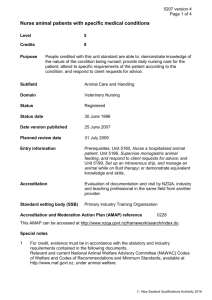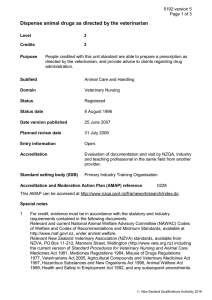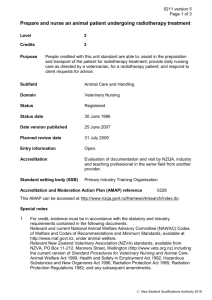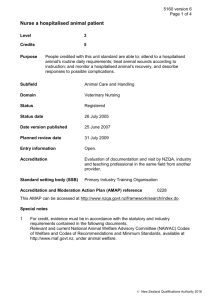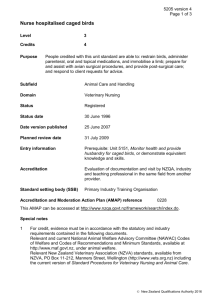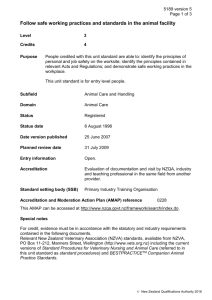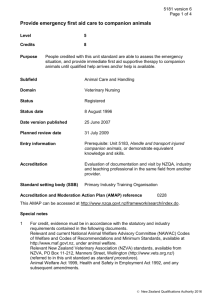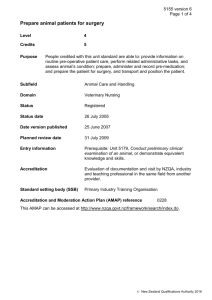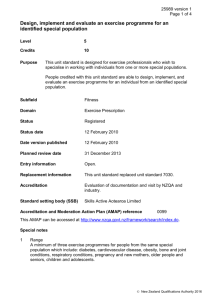5190 Provide emergency first aid for companion animals in
advertisement
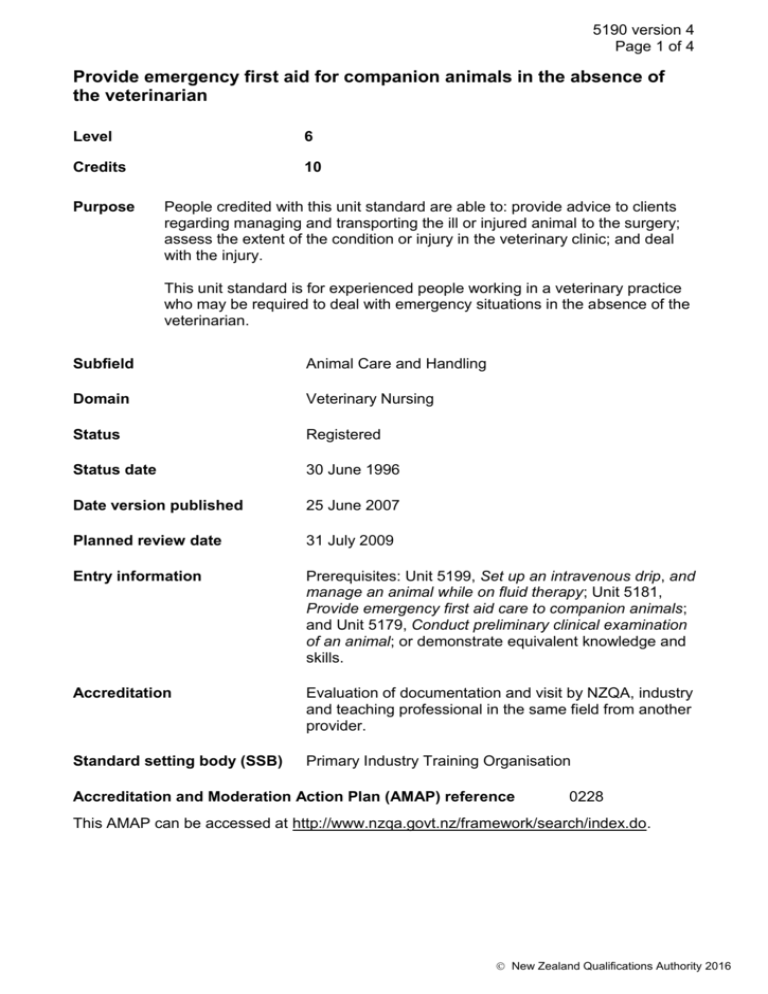
5190 version 4 Page 1 of 4 Provide emergency first aid for companion animals in the absence of the veterinarian Level 6 Credits 10 Purpose People credited with this unit standard are able to: provide advice to clients regarding managing and transporting the ill or injured animal to the surgery; assess the extent of the condition or injury in the veterinary clinic; and deal with the injury. This unit standard is for experienced people working in a veterinary practice who may be required to deal with emergency situations in the absence of the veterinarian. Subfield Animal Care and Handling Domain Veterinary Nursing Status Registered Status date 30 June 1996 Date version published 25 June 2007 Planned review date 31 July 2009 Entry information Prerequisites: Unit 5199, Set up an intravenous drip, and manage an animal while on fluid therapy; Unit 5181, Provide emergency first aid care to companion animals; and Unit 5179, Conduct preliminary clinical examination of an animal; or demonstrate equivalent knowledge and skills. Accreditation Evaluation of documentation and visit by NZQA, industry and teaching professional in the same field from another provider. Standard setting body (SSB) Primary Industry Training Organisation Accreditation and Moderation Action Plan (AMAP) reference 0228 This AMAP can be accessed at http://www.nzqa.govt.nz/framework/search/index.do. New Zealand Qualifications Authority 2016 5190 version 4 Page 2 of 4 Special notes 1 For credit, evidence must be in accordance with the statutory and industry requirements contained in the following documents. Relevant and current National Animal Welfare Advisory Committee (NAWAC) Codes of Welfare and Codes of Recommendations and Minimum Standards, available at http://www.maf.govt.nz, under animal welfare. Relevant New Zealand Veterinary Association (NZVA) standards, available from NZVA, PO Box 11-212, Manners Street, Wellington (http://www.vets.org.nz) including Standard Procedures for Veterinary Nursing and Animal Care (referred to in this unit standard as standard procedures). Animal Welfare Act 1999, Health and Safety in Employment Act 1992, and any subsequent amendments. 2 In-house procedures refer to the documented policies and procedures for animal handling and ethical behaviour codes required by the employer. 3 Underpinning Knowledge The following areas of knowledge underpin performance of the elements in this unit standard: Element 1 Immediate support of an emergency Transport methods according to injury and species Element 2 Poisons and Hazardous Chemicals, National Poisons Centre, Dunedin (03) 474 7000 (urgent), 0800 764 766 Signs/causes of poisoning/toxicities and treatments Signs and treatments for hypo and hyperglycaemia Identification and confirmation of death of patient Element 3 Methods of resuscitation Splint application Wound dressings Applications for hot/cold treatment Comfort requirements according to injury/illness. New Zealand Qualifications Authority 2016 5190 version 4 Page 3 of 4 Elements and performance criteria Element 1 Provide advice to clients regarding managing and transporting the ill or injured animal to the surgery. Performance criteria 1.1 History is verbally obtained of animal and injury or condition to enable assessment of extent of injury or condition. 1.2 Advice is provided to client regarding immediate support and management of the condition or injury prior to transport to veterinary surgery. Range road accident, haemorrhage, fractures, unconsciousness, collapse, fitting, vomiting, suspected poisoning, burns, scalds, wasp/bee stings, bites, sprains, hypothermia, hyperthermia, electrocution, foreign bodies, eclampsia, choking, diabetic coma, patient aggression. Element 2 Assess the extent of the condition or injury in the veterinary clinic. Performance criteria 2.1 Complete case history and patient detail is taken from client on arrival at the veterinary practice, according to practice protocol, to enable assessment of injury or condition. 2.2 A general examination is carried out, according to standard procedures, to assess condition. Range 2.3 behaviour, appearance, respiration pattern and rate, temperature, pulse rate, capillary refill time, colour of mucous membranes, haemorrhage, spinal injury or fracture. Veterinarian is contacted for advice and supportive treatment in terms of the assessment. Range telephone, cell phone, pager, radio telephone. New Zealand Qualifications Authority 2016 5190 version 4 Page 4 of 4 Element 3 Deal with the injury. Performance criteria 3.1 Immediate life support is provided, according to in-house procedures, to prevent further deterioration. Range 3.2 maintain airway, resuscitate, control haemorrhage, stabilise fractures or traumatised areas, dress wound, take blood and urine samples pre-treatment, administer medication, insert/stabilise intravenous cannula, administer fluid therapy, apply hot/cold compresses, induce emesis. After stabilisation, re-examination for re-assessment is carried out and vital signs are recorded according to standard procedures. Range respiration pattern and rate, pulse rate, temperature, colour of mucous membranes, capillary refill time, behaviour, appearance. 3.3 General comfort requirements are provided, according to species, to assist recovery. 3.4 Records are maintained according to in-house procedures. Please note Providers must be accredited by NZQA, or an inter-institutional body with delegated authority for quality assurance, before they can report credits from assessment against unit standards or deliver courses of study leading to that assessment. Industry Training Organisations must be accredited by NZQA before they can register credits from assessment against unit standards. Accredited providers and Industry Training Organisations assessing against unit standards must engage with the moderation system that applies to those standards. Accreditation requirements and an outline of the moderation system that applies to this standard are outlined in the Accreditation and Moderation Action Plan (AMAP). The AMAP also includes useful information about special requirements for organisations wishing to develop education and training programmes, such as minimum qualifications for tutors and assessors, and special resource requirements. Comments on this unit standard Please contact the Primary Industry Training Organisation standards@primaryito.ac.nz if you wish to suggest changes to the content of this unit standard. New Zealand Qualifications Authority 2016
